Set Theory is a branch of mathematical logic that deals with the study of sets, which are collections of objects. These objects can be anything: numbers, letters, or even other sets. Set theory forms the foundation of much of modern mathematics and provides a framework for discussing collections of mathematical objects.

Set Theory: Set Notations
We use these braces { } to enclose the elements of a set. for example
{7, 11, 13} is the set containing 7, 11, and 13.
- : means “such that“. for example {x : x > 2} is the set of all x such that x is greater than 2.
- ∈ means “is element of“. For example, 11 ∈ {7, 11, 13} asserts that 11 is an element of the set {7, 11, 13}.
- ∉ means “is not an element of“ for example 4 ∉ {7, 11, 13}. This is because 4 is not an element of the set {7, 11, 13}.
- ⊆ means ” is a subset of“ for example A ⊆ B asserts that A is a subset of B. This means every element of A is also an element of B.
- ⊂ means “is a proper subset of“. For example, A ⊂ B asserts that A is a proper subset of B. Every element of A is also an element of B. Nonetheless, A is not equal to B.
∩ means “Intersection of“. For example, A ∩ B is the intersection of A and B. It is the set containing all elements which are elements of both A and B.
- ∪ means “union of“. For example, A ∪ B is the union of A and B. It is the set containing all elements that are elements of A or B or both.
- × means “Cartesian product of“. For example, A × B is the Cartesian product of A and B. It is the set of all ordered pairs (a, b) with a ∈ A and b ∈ B.
- \ means “set difference between”. For example, A \ B represents the set difference between A and B. It is the set containing all elements of A which are not elements of B.
- A’ or Ac means “complement of set A”.
- The complement of A (AC)is the set of everything which is not an element of A.
- |A| means “cardinality or size of A“.
- The cardinality (or size) of A is the number of elements in A sometimes written as n(A).
Sets Relationships
Two sets are be equal if they have exactly the same elements. For example, {7, 11, 13} = {11, 7, 13}. Each element in the first set is the same as in the second set.
The order in which the elements are written down in does not matter.
{7, 11, 13} = {7, 8 + 3, 6 + 2 + 5} = {VI, XI, XIII} = {7, 11, 13, 7 + 6}
The above statement shows that the representation of elements in a set does not matter. Only the final evaluated value is important.
Consider the sets A = {7, 11, 13} and B = {7, 11, 13, 20}.
A and B are not equal but every element of A is also an element of B.
we say that A is a subset of B, or in symbols A ⊂ B or A ⊆ B.
Both symbols are read “is a subset of.”
This is analogous to the difference between < and ≤.
⊆ is analogous to ≤ and ⊂ comparable to <.
power set Notations
power set of a subset A is the set made from all possible subsets of A.
power set of A is often written as P(A) or sometimes as 2A .
consider the set A = {5, 7, 9}.
P(A) ={ ∅, {5}, {7}, {9}, {5, 7}, {5, 9}, {7, 9}, {5, 7, 9}}.
If the set A has n elements, then the power set has 2n elements.
Please note that all elements of power set P(A) are sets and NOT number elements. Therefore; 5 ∉ P(A) but {5} ∈ P(A) since elements of P(A) are not numbers but sets.
NOTE:
{5} ⊄ P(A) because not everything in {5} is in P(A).
But, {{5}} ⊆ P(A).
The only element of {{5}} is the set {5} which is also an element of P(A).
cardinality of a set
The cardinality of a set is the number of distinct elements it includes. It is often referred to as the size of the set.
A set like A = {a, b, c, d, e, f} has 6 distinct elements. Hence, its cardinality is 6. that is |A|=6.
For a set with a finite number of elements, the cardinality is simply the number of elements in the set.
The cardinality of the set B = {1, 2, 3, 4, 1, 2, 3} is 4. It has 4 distinct elements. Repeated elements are not counted when determining cardinality of a set.
Related topics
- Sets
- Set Notations
- Operations on set
- Venn Diagrams
- Cardinality In sets
- set Identities
- Integration by parts-1: Excellent Concise approach
- Sets: A concise introduction
- Home


Leave a Reply